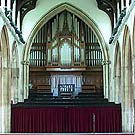Common Hall

Base layers
Data layers

Other Images
Venue Type & Location
Site Name: Common Hall
Location: Norwich
County: Norwich (city-county) in Norfolk
Location Type: Town - in town at determined location
Overview
The site of the former Dominican Friary church, built of flint with stone and brick dressings, is located a short distance NW of the market place at the intersection of Wymer and Blackfriars’ Streets (now St Andrew’s and St George’s Streets).
Performance History
As the seat of civic government and centre for festive occasions after its purchase and remodelling in the 1540s, the common hall was probably the venue for most performances by touring entertainers before the mayor and city officials until the early 17th c. The chapel in the former chancel of the Blackfriars church was also licensed for use by members of the Queen's and Prince's Men in 1616.
Current Status
Still in regular use for civic occasions but also available for conferences, weddings, concerts and meetings.
History of the Venue
1307 Dominican friars acquired site for Blackfriars Priory.
1327 Building of the church begun.
1345 W end of the church and cloister completed.
1413 Church badly damaged in a fire. Roof and most of the window tracery replaced.
ca. 1459 Central tower built over the nave crossing.
1538 Surrender of the priory to the Crown. Buildings decayed; contents, including organs, sold.
1540 City purchased the former priory buildings from the Crown for £81 (paid in 2 installments, 1540, 1544). Extensive repairs and refurbishments followed, the lost paving renewed by tiles brought from the church of the Grey Friars and other tiles bought in Yarmouth for the former chancel (now the chapel) (Sutermeister, Blackfriars 9). early 1540s The nave of the church was converted for use as the primary civic hall for a variety of functions. The chancel became a municipal chapel dedicated to St John and furnished with stools and desks. Some images remained. Rails added for hangings in the chapel and a wainsc ott ed chest for vestments was acquired. 3 new lecterns added (Sutermeister, Blackfriars 10).
1549 Buildings were put up at the W end to cater for banquets. 'An inventory ... mentioned a pantry, buttery, kitchen, "scalding house", backhouse, "buttyng house", wet and dry larders and a counting house in the cloister with all the equipment for catering on a large scale (Sutermeister, Blackfriars 10). Rood loft dismantled.
1565 Chapel used by Flemish residents of Norwich, becoming known as the 'Dutch Church.'
1712 Tower fell, causing damage to both the common hall and the chapel.
1828 Norwich Music Festival began in the hall.
ca. 1863 Extensive restoration under the direction of T.D. Barry, the city surveyor. Service rooms and original SW entrance porch demolished during restoration and a new W wall with large Victorian Gothic window constructed. New S porch built 1 bay towards the E with an arch at the E end of the hall and a smaller door added in the third bay at around the same time.
1970 New stage, pull-out seating and double glazing added to the common hall, now named St Andrew's Hall. Chapel, now known as Blackfriars' Hall, redecorated with oak panelling and a display of civic portraits.
Record Source
REED Norwich
Bibliographic Sources
-
The History of the City and County of Norwich from the Earliest Accounts to the Present Time. 2 vols. Norwich: John Crouse, 1768.
-
The History of the City and County of Norwich from the Earliest Accounts to the Present Time. 2 vols. Norwich: John Crouse, 1768.
-
King, Daniel. The Cathedrall and Conventuall Churches of England and Wales. London: John Overton, 1672.
-
McMillin, Scott, and Sally-Beth MacLean. The Queen's Men and their Plays. Cambridge: Cambridge UP, 1998.
-
Pevsner, Nikolaus, and Bill Wilson. Norfolk I: Norwich and North-East. 1962. The Buildings of England. London: Penguin Books, 1997.
-
'Report of the Summer Meeting of the Royal Archaeological Institute at Norwich 1979.' Archaeological Journal 137 1980: 280–368.
-
Rowan, D.F. 'The Players and Playing Places of Norwich.' . The Development of Shakespeare's Theater. Astington, John H., ed. New York: AMS P, 1992.
-
Shaw, Michael. The Norwich Blackfriars: a History and Guide to the Friary. Norwich: City of Norwich Amenities, nd.
-
Sutermeister, Helen. The Norwich Blackfriars: An Historical Guide to the Friary and its Buildings up to the Present Day. Norwich: City of Norwich in conjunction with the Norwich Survey, 1977.
-
Tittler, Robert. Architecture and Power: The Town Hall and the English Urban Community c. 1500–1640. Oxford: Clarendon P, 1991.
-
William Worcestre Itineraries. Harvey, John H., ed. Oxford: Clarendon P, 1969.





